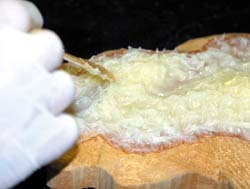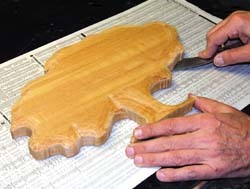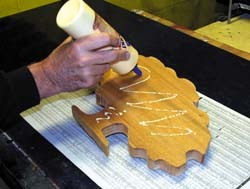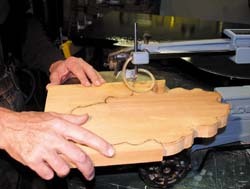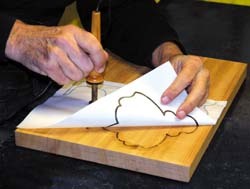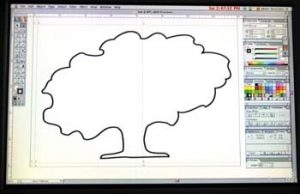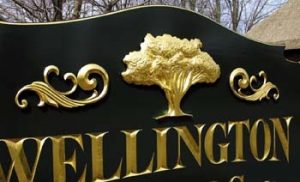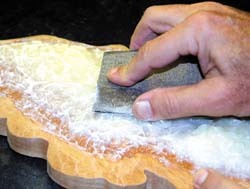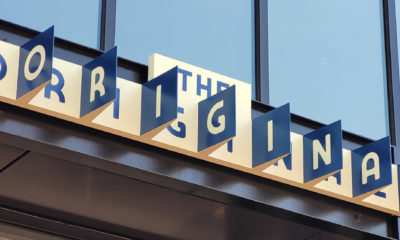Dimensional Signs
Lovely as a Tree
Sculpting a high-relief applique
Published
18 years agoon
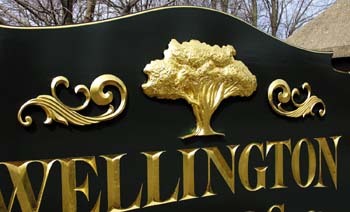
With deepest apologies to Joyce Kilmore and God, it is possible to sculpt a high-relief, dimensional, appliqué. Replicating trees with this method is the highest form of flattery; read on to learn this technique, which can beautify any sign panel.
Making a template
First, I needed a good tree rendering; a dramatic silhouette is preferable to a conventional, symmetric shape. A Google.com search yielded more than 250,000 images. Fortunately, I found an attractive oak-tree drawing within the first 500 listings. I printed, scanned and outlined the image using Adobe Illustrator® on my Mac® G4 computer.
Then, I printed the outlined tree onto high-quality tracing paper using my HP LaserJet 2200d printer. Because laser printers deposit carbon particles onto a substrate to reproduce images on paper, it’s possible to transfer the artwork to a piece of mahogany or HDU by applying heat from a heat-transfer pen or household iron.
Next, I cut out the silhouette using a scroll saw with a spiral blade. A saber saw can accomplish the task, but a spiral blade moves the panel in any direction while cutting. This is especially helpful when navigating many small arcs and curves.
Carving time
AdvertisementAfter I cut out the silhouette, I was ready to carve around the edges and trunk. I secured the cutout to the workbench by first covering the tabletop with newspaper, using a few zigzag beads of yellow carpenter’s glue. Next, I applied glue to the cutout’s back, and I pressed the silhouette onto the newspaper.
This technique provides excellent adhesion with minimal glue. Alternately, the cutout could be attached to a piece of wood as a base and secured to the bench’s top with a clamp. The latter approach would facilitate orienting the cutout in any direction desired. Removing the cutout is quick and easy with a flexible, metal, paint scraper.
The only required chisel carving is on the trunk and edges. To detail the tree trunk, I made a pencil sketch of an actual tree and placed it upon the silhouette to serve as a guide. Next, I tapered the tree’s entire edge and sloped it approximately 60°.
To give the tree the illusion of full-bodied girth, without carving away any material, I added material by "sculpting" with a two-part epoxy; this comprises an epoxy resin and a hardener. Having mixed both parts, I liberally applied a generous amount of colloidal silica powder until I’d created a paste that’s roughly the consistency of peanut butter. Without silica, the epoxy’s texture would be syrupy; thus, it becomes much more workable.
With a tongue depressor, I began sculpting. As the epoxy built up on the silhouette, I twisted my applicator to provide the desired effect of leaf detail. A careful study beforehand of actual trees helped produce a realistic effect, such as the crests and valleys in an actual tree’s surface structure.
Once I’d reached my desired high-relief texture on the silhouette, I cured the epoxy paste overnight. After the epoxy hardened, I removed the sharp points and edges I’d created during the sculpting phase. Then, I sanded it by hand; aggressive, 60- or 80-grit sandpaper does the job well. I followed with 120-grit to smooth its texture.
AdvertisementBeautification
The newly sculpted tree is now ready for size and gilding. At this point, I could’ve molded and cast the sculptured tree and produced multiple copies to be used in future applications (see ST, May 2003, page 40). If you do so, begin the moldmaking process after the following coating procedure.
Polyurethane-resin castings (created using the procedure in my May column) don’t require primer when you use Krylon® Fusion spraypaint; the paint fuses with the plastic casting.
However, for wood originals, I apply three coats of Krylon® automotive primer before applying several coats of black paint. I chose black because the vertical edge on the finished tree will provide an attractive, emphatic border. Not gilding the sides also simplified sizing and gilding procedures, and permitted easy handling during installation onto the panel. To avoid goldleaf inadvertently sticking to the black sides, I dusted the periphery with gilder’s rouge — talcum powder also works.
Before sizing and gilding, Lestingi applied Krylon® Fusion spraypaint.
Advertisement
Prior to gilding, he applied three coats of Krylon automotive primer prior to several coats of black paint, which provides an emphatic border to the tree’s edge.
Using a gilder’s tip, Lestingi applied 23k looseleaf, double gold.
I sized the sculpture using LeFranc’s slow size with a bit of 1Shot® chrome-yellow lettering enamel, which I added as a color indicator. The longer the size cures, the greater the gild’s brilliance; the size may cure in 12 to 48 hours.
Because genuine, 23k gold is only 0.0001 in. thick, it can’t be handled using your finger. The traditional goldleaf applicator is the gilder’s tip brush. First, I "charged" the brush with oil (not static electricity, as some mistakenly believe), which allowed gold to attach to the oil on the brush (I used ChapStick™ lip balm). Simply rubbing it on my hand made it easy to use.
Voilá! Having used a white-sable brush to create the impression of leaves, Lestingi finished his creation. Against a backdrop of God’s creation, judge for yourself the authenticity of Lestingi’s work.
I lightly swiped the gilder’s tip into the balm across my hand; the tip easily lifted the leaves away from their sheets. Goldleaf attached to the sculpture, because the size’s tack is greater than the oil on the brush.
After I covered the tree with gold, I looked for any missing spots, or holidays. I filled these with small pieces of leaf, which I transferred from the leaf booklet to the tree by using a 1/2-in., white-sable brush. Placing a piece of cardboard under the leaf helps make it rigid and easier to lift from the page; I easily dislodged my desired amount of gold and placed it on the sculpture. Finally, I used the white-sable brush to detail myriad pieces that represent the tree’s multitude of leaves.
I attached it to the sign by twisting three studs into the appliqué’s back and inserting them inside silicone-filled holes that drilled into the signface.
This practically foolproof tree appliqué is now ready to adorn a sign, and confers an aura of dignity and elegance.
| More on Francis |
|
Signs of Gold Inc. (Williamsville, NY) owner Francis Lestingi, a Queens, NY native, taught himself pen calligraphy and brush lettering during his youth. By high school, he’d learned how to gild and handletter storefront paper signs. After high school, Lestingi entered the Christian Brothers religious teaching order, where he earned physics degrees from Catholic University and Rensselaer Polytechnic Institute. Later, he taught physics, chemistry and theology at high schools in Rhode Island and throughout New York City. During his tenure, Harvard University hired him to design transparencies for a high-school physics course for the National Science Foundation. After leaving the Order, he earned a doctorate at the University of Wisconsin, and taught physics and scientific history at SUNY-Buffalo, earning the President’s and Chancellor’s Awards for Excellence in Teaching. Ten years ago, while still teaching, Lestingi decided to return to the "lettering arts" and founded Signs of Gold. He soon took early retirement and began carving fulltime. He’s garnered two first-place awards in USSC Sign Design Competitions. |
| Equipment and Materials |
|
Brushes: Soft, flat, 3/8- and 1/2-in. lettering brushes, from Andrew Mack & Son Brush Co. (Jonesville, MI), (517) 849-9272; gilder’s tip, from Leo Uhlfelder & Co. (Mt. Vernon, NY), (914) 664-8701; 1/2-in., white sable brush, available from art-supply stores. Electronics: Apple® Mac G4 computer, from Apple Computer (Cupertino, CA) (408) 996-1010 or www.apple.com; Epson Perfection 1640SU scanner, from Epson (Long Beach, CA), (800) 873-7766 or www.epson.com; HP® LaserJet 2200d printer, from Hewlett-Packard (Palo Alto, CA), (800) 752-0900 or www.hp.com. Epoxy: Two-part, West Systems Epoxy 405, from Gougeon Brothers Inc. (Bay City, MI), (989) 684-7286, available from such woodworking stores as Rocklers; and colloidal silica powder, available from art-supply and woodworking stores. Gilding: LeFranc Charbonnel slow size, from LeFranc & Bourgeois Inc. (René, France), available at such distributors as Colart Americas Inc. (Piscataway, NJ), (732) 562-0770; gilder’s rouge and 23k ducat, looseleaf, double gold, from Leo Uhlfelder & Co. Paint: Krylon automotive primer and high-gloss, black spraypaint, available at hardware tores; 1Shot chrome-yellow lettering enamel, from One Shot LLC (Gary, IN), (219) 949-1684. Paper: Vellum, 16-lb. tracing paper, from Clearprint Drafting and Design (Emeryville, CA), (800) 766-7337. Substrate: Mahogany sign panel, from KenCo Wood Products (Buffalo, NY), (800) 757-9142. Tools: Various chisels and gouges, a heat-transfer pen and Delta scroll saw, available from WoodCraft (Parkersburg, WV), (800) 225-1153; carpenters’ yellow glue and 60-, 80- and 120-grit sandpaper, available from hardware tores. Miscellaneous: Tongue depressors, lip balm and talcum powder, available at drugstores. |

SPONSORED VIDEO
Introducing the Sign Industry Podcast
The Sign Industry Podcast is a platform for every sign person out there — from the old-timers who bent neon and hand-lettered boats to those venturing into new technologies — we want to get their stories out for everyone to hear. Come join us and listen to stories, learn tricks or techniques, and get insights of what’s to come. We are the world’s second oldest profession. The folks who started the world’s oldest profession needed a sign.
You may like

ISA Announces New Tradeshows and Meetings VP

5 Reasons to Sell a Sign Company Plus 6 Options

Sign Products Wrap-Up for April
Subscribe

Bulletins
Get the most important news and business ideas from Signs of the Times magazine's news bulletin.
Most Popular
-

 Tip Sheet1 week ago
Tip Sheet1 week agoAlways Brand Yourself and Wear Fewer Hats — Two of April’s Sign Tips
-

 Ask Signs of the Times2 days ago
Ask Signs of the Times2 days agoWhy Are Signs from Canva so Overloaded and Similar?
-

 Real Deal1 week ago
Real Deal1 week agoA Woman Sign Company Owner Confronts a Sexist Wholesaler
-

 Benchmarks5 days ago
Benchmarks5 days ago6 Sports Venue Signs Deserving a Standing Ovation
-

 Editor's Note2 weeks ago
Editor's Note2 weeks agoWhy We Still Need the Women in Signs Award
-

 Women in Signs1 week ago
Women in Signs1 week ago2024 Women in Signs: Megan Bradley
-

 Product Buying + Technology2 weeks ago
Product Buying + Technology2 weeks agoADA Signs and More Uses for Engraving Machines
-

 Photo Gallery7 days ago
Photo Gallery7 days ago21 Larry Albright Plasma Globes, Crackle Tubes and More
